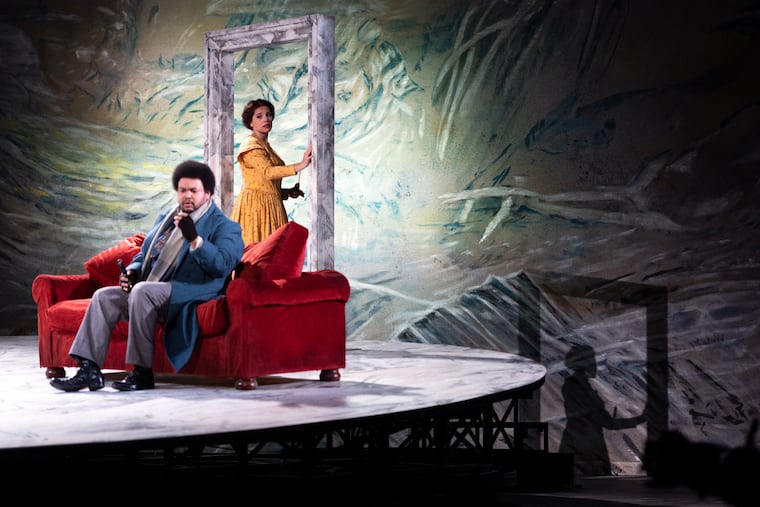Opera Philadelphia is taking its new ‘La bohème’ forward through flashbacks
The new production sheds a new perspective on Puccini standard.

Director Yuval Sharon plays with the operatic space-time continuum in La bohème, the Puccini classic now being presented by Opera Philadelphia, shrinking the opera and presenting its four acts in backward order.
Traditionalists may roll their eyes here and ask why?
“It must be the most popular opera of all time, but I think that can sometimes be to its detriment, because we all know how it goes,” says Sharon. “And there is a sense of real conventional listening and viewing that now is such a part of bohème that we can almost sing along with it, that we also all expect everything to happen exactly the way that it always does.”
Of course, we don’t all know how La bohème goes, and many who do remain captivated by an evocative orchestral soundworld and vocal parts that, in the hands of the right singers and conductor, go right to the soul.
Still, Sharon’s point about the opera’s familiarity is well-taken. This is the 10th time Opera Philadelphia has presented the work since 1977, which means it comes around every four or five years.
The lack of fresh ears “is a joy that I think is taken away from a lot of operagoers the more often they see bohème,” he says. “So I think part of this was a spirit of trying to figure out a way that could actually provide a way to listen to and experience bohème as if it was for the first time.”
Now, in this version — led by music director Corrado Rovaris with Joshua Blue as Rodolfo and Kara Goodrich as Mimì — the famed story of a group of struggling artists will go like this:
Mimì and Rodolfo profess their love for each other. They had a tiff, but have now decided to stay together until spring. Mimì, Rodolfo, and their friends all go out for a celebration at the Cafe Momus. Mimì and Rodolfo walk off together on a high note.
Sharon’s retrograde concept gets the part about Mimì dying out of the way early on, and while that may seem like a detail that’s hard to put out of your mind as the story progresses, remember, it’s opera. Strauss’ Daphne ends with the heroine turning into a tree.
Part of what spurred the idea of a happy ending was COVID-19 and the subsequent shutdown.
“We’re coming from a period of death and sickness, and so much loss,” says Sharon, who is artistic director of Detroit Opera, where this production debuted a year ago. “But to come back to the theater means not emphasizing that in a way.”
The idea of a La bohème in reverse order was first raised about a decade ago in a conversation between Sharon and set designer John Conklin, “and that idea really stuck with me. And I went home and created a playlist of the acts in that order and realized I was listening to this very familiar opera in a completely different way,” said Sharon. “Characterizations felt totally different, so that by the time we got to Act I, it felt so moving and so touching to see that despite how it ends, that love still felt so authentic and true.”
Sharon created a new speaking character, a kind of meta-observer called the Wanderer, to help frame the story, “because I did feel like we needed to make sure that the audience can follow our reverse chronology. I didn’t want to just assume that everyone will have read the program.”
The production has shrunk, too. Sets are minimal, the stage band in the Latin Quarter scene culled, the episode with landlord Benoit cut, intermission eliminated, and the action centers on a raised, round stage platform that sometimes rotates.
“I really wanted to just strip away everything that is not essential to this piece. So the sets are quite bare, actually. We take away what most people expect of a bohème, which is this picture postcard, you know, very big, cumbersome sets that require three intermissions.”
That “performance tradition has suffocated the work, it’s made it kind of bloated, overstated, and it’s about this young, restless group of wannabe artists — you know, they’re not even artists yet.”
» READ MORE: Corsets, topcoats, military jackets, and shoes. How Opera Philadelphia fits 85 costumes for ‘La bohème’
What would Puccini think?
“The fact that he’s no longer with us means his works don’t belong to him anymore,” Sharon said. “His works belong to us now, you know, and it’s our responsibility to keep exploring what is in these pieces.”
Conventional productions of La bohème aren’t going away, Sharon points out. Franco Zeffirelli’s epic Metropolitan Opera production, 42 years old and counting, appears regularly at the Met; it’s now running there through June 9 with Yannick Nézet-Séguin, then James Gaffigan, on the podium. Recordings and videos of productions both traditional and experimental are plentiful, and it’s safe to say that Opera Philadelphia will bring back La bohème again soon.
Maybe next time the troupe will do something truly shocking — like a luxuriously appointed, lush, traditional production.
“This is not meant to supplant,” says Sharon. “This is meant to shed a new perspective on the piece. I do really hope that this encourages audiences to not think of operas as these frozen pictures in time. They really are malleable, they go with the flow of time and they change with time.”
La bohème is performed April 28 at 8 p.m., April 30 at 2 p.m., May 5 at 8 p.m., and May 7 at 2 p.m. at the Academy of Music, Broad and Locust Streets. In Italian with English supertitles, no intermission. Corrado Rovaris conducts the Opera Philadelphia Orchestra with a cast that includes Joshua Blue as Rodolfo, Kara Goodrich as Mimì, Troy Cook as Marcello, and Melissa Joseph as Musetta. Tickets are $25-$299. operaphila.org, 215-732-8400.